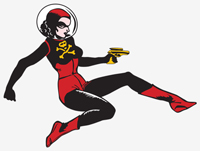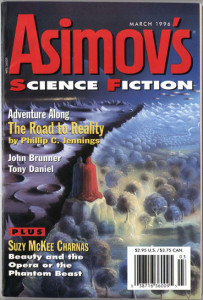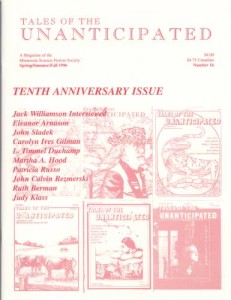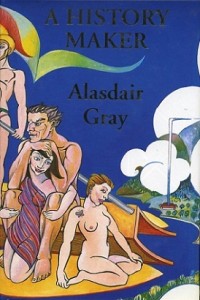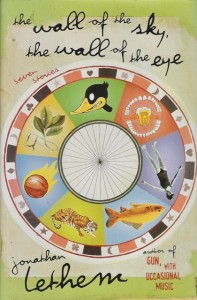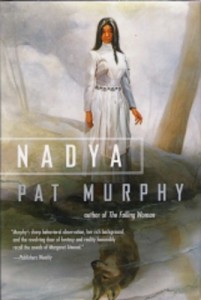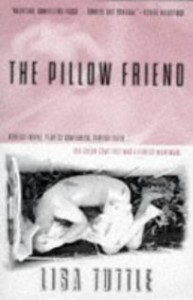In addition to selecting the winner, each jury chooses an Honor List (previously called a “Short List”). The Honor List is a strong part of the award’s identity and is used by many professors as a guide to creating syllabi and by many readers as a recommended reading list.
Honor List
The 1996 jury chose 10 works for the Honor List
“The Silent Woman” is not a short story, but a stand-alone chapter in the novel Farewell I’m Bound to Leave You. A wonderful exploration of “womanliness” which transforms the supposed passive virtue of silence into an almost magic strength. — Justine Larbalestier At the end of the millennium, noise is king. Flying in the face of that, this is a story that dares to explore the power and beauty of silence. And it does so beautifully, creating an exquisite object, like a literary Faberge egg. — Richard Kadrey In this gorgeous re-imagining of The Phantom of the Opera, Christine strikes a bargain with the Phantom and lives with him for five years. Much of the story has to do with the precarious balance of power between the two. Christine has a moral hold over the Phantom, but she doesn’t take it upon herself to absolve him, to reform him in any absolute sense, or to sacrifice herself to him. He remains a monster, and not always a sympathetic one. Their passion is based on this tension, and of course it’s one that can’t endure indefinitely, as Christine knows. The moral and psychological complexity of this story can’t be easily summarized. Think of it as an antidote to the fable of the evil man redeemed by the love of a good woman, but don’t stop there; it’s many other things as well. — Janet M. Lafler A fascinating exploration of domesticity and power and literary roles. Even though she’s the heroine of a Romance, Christine is no fainting, yielding, pliable victim. She is a hard-headed business woman who knows how to negotiate with managers and directors and monsters, too. Erik, on the other hand, is governed completely by his passions. In most Romances, the heroine must teach the hero to feel and to express his feelings. In “Beauty,” it’s the other way around. — Delia Sherman Thematically perfect for the Tiptree. I admired its brains and awareness of its subject matter immensely. It’s a wonderfully imagined externalization of all the little decisions we make every day that add up to who we will be as adults. Only in Duchamp’s world, the decisions are entirely self-conscious and deliberate and revolve around the gender role you will carry, like a big digitally-crafted, chrome albatross around your neck for the rest of your life. — Richard Kadrey In this story, an apparent gender freedom (the ability to choose one’s gender at a certain age) is embedded within a rigid gender system. A pointed commentary on the problem of “choice” when none of the options is worth choosing. — Janet M. Lafler In this “post-historical utopia,” which one of the characters describes as a “mild matriarchy,” women live in communal households and raise children, while most men live separately and pursue “manly” activities such as warfare. Sound familiar? That’s just the beginning. This is a funny, loony, and irreverent book, but it also has flashes of horror, despair, and lyricism, not to mention the best portrayal of warfare-as-sport that I’ve ever read. — Janet M. Lafler A story of heterosexual love as a sick compulsion. In this sharp, funny, clever story the disease undoes the very fabric of time and space. Straight men and women are aliens locked into combat until the end of time. Literally. — Justine Larbalestier The reductio ad absurdum of “can’t live with ’em, can’t live without ’em.” — Delia Sherman This is a book primarily about questions. As the protagonist comes of age at the opening of the western US, she begins to question everything in her world, including her identity and the settled life that she is expected to grow into. When she makes one crucial break with her past (avenging the killing of her parents), the questions deepen, encompassing everything, including her sexuality. What makes the book work is that the questions aren’t obvious and political in the soapbox sense, but grow out of the increasing natural awareness of a young woman moving into and finally rejecting the “civilized” world. — Richard Kadrey An exploration of (among other things) the borders between male and female, masculine and feminine. Nadya herself slides from man to woman as she slides from woman to wolf, redefining gender in the face of a society whose gender definitions are as unrelenting as they are arbitrary. The characters are persuasive, the background is colorful and beautifully researched, and there’s enough suspense and adventure to make it a convincing Western. A feminist Western. Well, that’s gender-bending, too. — Delia Sherman I thought the use of fairy-tale elements, while fun, was a bit easy and undisciplined. (Picture me with my arms folded and a stern look on my face. Undisciplined use of fairy-tale elements! Capital crime.) But I loved the identification of the fairytale godmother with death. If death seemed to be a little more the topic than sex, there was plenty of sexual stuff going on. It was a great read, with many beautiful moments. A top contender. — Karen Joy Fowler Pollack is interested in playing with types of fairy tale and contemporary society. In Pollack’s universe, the only real sin seems to be too strict adherence to one traditional gender. What I liked (and found Tiptreesque) about this book was the androgyny of many of the characters (especially the dead and inhuman ones). If the Le Guin is an exploration of Things as They Might Be, Godmother Night is an exploration of Things as They’re Getting to Be, with “gendered” behaviors like nurturing, passing judgment, avoiding intimacy, and wearing dresses seen more as a function of individual personality than of biological programming or social expectation. — Delia Sherman Not all horror novels have monsters and not all monsters have scales and wings. This is a novel about the horror of daily existence, of desire for an impossible “perfect” union. Where longing makes the whole world gray and seemingly constructed of chalk. — Richard Kadrey I had a visceral reaction to this novel-I loved it and simultaneously found it extremely disturbing. It captures perfectly one of the main reasons that people (particularly women) stay in bad relationships, ignore warning signs, and pretend to enjoy bad sex-because they’re stuck in their hopes and dreams from the beginning of the relationship, when they thought it was going to be the answer to all their desires. Thus, The Pillow Friend can be read as a story about the ways that both women and men are imprisoned by fantasies of romantic fulfillment; about the frustrated desire for perfect connection with another; and about the destructiveness of that desire. — Janet M. Lafler This story derives its impact from its position among other feminist texts to do with naming and unnaming (including the Biblical one). A young woman isolated on a remote planet creates her own words. A lovely variation on a favorite theme. — Karen Joy Fowler This story is rich with echoes of earlier science fiction by women. Like Suzette Haden Elgin’s fascinating Native Tongue trilogy, language is used to remake the world. However, this time it is one woman and her child who reinscribe the world in which they find themselves. The scenario of a young woman bringing up her child alone on a planet reminds me of Marion Zimmer Bradley’s 1959 story “The Wind People” though in Williams’ story the woman and her child reinvent their world rather than letting it invent them. — Justine Larbalestier This was one of my personal favorites among the books we read this year. Although it alludes to some fantastical mathematics, the fantasy content is minimal. It involves a family in which mathematical genius runs, unacknowledged and primarily untrained, through the female line. It deals with issues of women in (and out of) academia, of the appropriation of women’s work, and offers a quick education in the female mathematical tradition, sparse, but there. But the heart is a three-generational mother and daughter story. Beautifully written, absolutely original. Sensational! — Karen Joy Fowler I really loved this book. It’s about a famous mathematician, Frances Montrose, and is her history from the 1950s when she was a child until the discovery of her genius in the late 1990s. The novel centres around two first person narratives. The first I is that of Frances’ daughter, Hypatia Montrose, who is trying to come to terms with her extremely difficult relationship with her mother. The second is Frances’ I. However, the stories of this I are told as imagined by Hypatia. It is one of the most dazzlingly beautiful negotiations of the lives and relations of mothers and daughters that I have ever read. — Justine LarbalestierThe Silent Woman by Fred Chappell (St. Martin's Press, 1996)
Work Information
Title: The Silent WomanAuthor: Fred ChappellCollection:
Title: Farewell, I'm Bound to Leave You Publisher:
Publisher Name: St. Martin's PressCountry: USYear: 1996Beauty and the Opéra or The Phanton Beast by Suzy McKee Charnas (Dell Magazines, 1996)
Work Information
Title: Beauty and the Opéra or The Phanton Beast Author: Suzy McKee CharnasCollection:
Title: Isaac Asimov's Science Fiction Magazine March 1996Editor: Gardner DozoisPublisher:
Publisher Name: Dell MagazinesCountry: USYear: 1996Welcome, Kid, to the Real World by L. Timmel Duchamp (Minnesota Science Fiction Society, 1996)
Work Information
Title: Welcome, Kid, to the Real WorldAuthor: L. Timmel DuchampCollection:
Title: Tales of the Unanticipated Spring/Summer/Fall 1996Editor: Eric M. HeidemanPublisher:
Publisher Name: Minnesota Science Fiction SocietyCountry: USYear: 1996A History Maker by Alasdair Gray (Canongate Books, 1994)
Work Information
Title: A History MakerAuthor: Alasdair GrayPublisher:
Publisher Name: Canongate BooksCountry: ScotlandYear: 1994Five Fucks by Jonathan Lethem (Harcourt Brace, 1996)
Work Information
Title: Five FucksAuthor: Jonathan LethemCollection:
Title: The Wall of the Sky, The Wall of the Eye Publisher:
Publisher Name: Harcourt BraceCountry: USYear: 1996Nadya by Pat Murphy (Tor, 1996)
Work Information
Title: NadyaAuthor: Pat MurphyPublisher:
Publisher Name: TorCountry: USYear: 1996Godmother Night by Rachel Pollack (St. Martin's Press, 1996)
Work Information
Title: Godmother NightAuthor: Rachel PollackPublisher:
Publisher Name: St. Martin's PressCountry: USYear: 1996The Pillow Friend by Lisa Tuttle (White Wolf Publishing, 1996)
Work Information
Title: The Pillow FriendAuthor: Lisa TuttlePublisher:
Publisher Name: White Wolf PublishingCountry: USYear: 1996And She Was the Word by Tess Williams (Eidolon Publications, 1996)
Work Information
Title: And She Was the WordAuthor: Tess WilliamsCollection:
Title: Eidolon: The Journal of Australian Science Fiction and Fantasy 22/23Editors: Jonathan Strahan, Jeremy G. Byrne, Richard ScrivenPublisher:
Publisher Name: Eidolon PublicationsCountry: AustraliaYear: 1996Leaning Towards Infinity by Sue Woolfe (Faber & Faber, 1996)
Work Information
Title: Leaning Towards InfinityAuthor: Sue WoolfePublisher:
Publisher Name: Faber & FaberCountry: AustraliaYear: 1996
